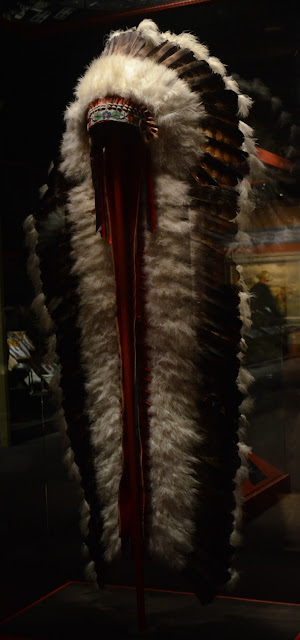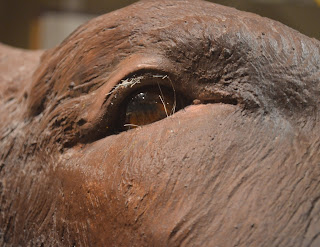Bronc Riding is serious stuff. Rodeo got started in ranch corrals where cowboys could show off and have a little fun with the skills they used every working day. Horses were intrinsic, of course. Bull riding came later..probably on a dare.
If you happen to look through a fence, sometime, and see an eye like the one below looking back..that's a Bull's Eye, Friend, and you will do well to go on about your business..someplace else.
But if you do sign up to ride, you can check a specific bull in the record books and see how he's done in the past. Skilled riders study the bull..see how he steps out of the chute and how he will turn so the rider will be able to anticipate the animal's moves.
By the way, the Bull usually wins.
It ain't easy, I think. I shall remain an interested observer, thank you very much.
-0-
 |
| End of the Trail |
 |
| Lincoln.
This statue of Abraham Lincoln is at the other end of the main corridor.
-0- But art takes many forms. |
 |
| Chief's Head Dress |
 |
| Rooster Cogburn's head dress & eyepatch. John Wayne Collection |
 |
| "Fill Your Hand." John Wayne collection. |
The movie cowboys have a gallery, of course. They are an important part of how the old west is viewed, even though some of it is pretty far-fetched. But some isn't. The movies may be how a great many of us got our first glimpse of that history. I know I spent a lot of Saturday mornings at the Morgan Theater, watching a western, a serial and 17 cartoons. Impressions are made in a lot of ways.
But, yes..that's Wayne's famous six shooter. In the movies, its grip looked orange; in reality, it's ivory, turned a beautiful, soft color by years of handling and exposure to the sun. The oils in our hands can do that to real ivory..and that's real ivory.
 |
| Lock 'em up. And if you don't behave yourself, the Marshall is just across the street |









No comments:
Post a Comment